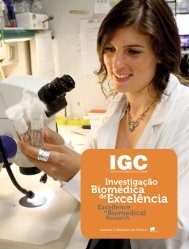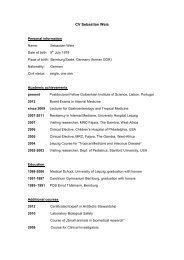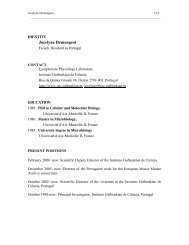organisation - the Instituto Gulbenkian de Ciência
organisation - the Instituto Gulbenkian de Ciência
organisation - the Instituto Gulbenkian de Ciência
- No tags were found...
You also want an ePaper? Increase the reach of your titles
YUMPU automatically turns print PDFs into web optimized ePapers that Google loves.
BACTERIAL<br />
SIGNALLING<br />
Karina B. Xavier Principal Investigator<br />
PhD in Biochemistry, Universida<strong>de</strong> Nova <strong>de</strong> Lisboa, 1999<br />
Research Scientist, Princeton University, USA<br />
Principal Investigator at <strong>the</strong> IGC since 2006<br />
Bacteria use small molecules called autoinducers to communicate with one ano<strong>the</strong>r<br />
by a process called quorum sensing. This process enables bacteria to regulate<br />
behaviours which are only productive when many bacteria act as a group,<br />
similarly to multi-cellular organisms. Behaviours regulated by quorum sensing<br />
are often crucial for successful bacterial-host relationships whe<strong>the</strong>r symbiotic<br />
or pathogenic. We use an integrative approach, from molecules to circuits, to<br />
un<strong>de</strong>rstand <strong>the</strong> role of quorum sensing in bacterial behaviours. Our research<br />
involves elucidation of <strong>the</strong> molecules used as signals, <strong>the</strong> network components<br />
involved in <strong>de</strong>tecting <strong>the</strong> signals and processing information insi<strong>de</strong> individual<br />
cells, and characterisation of <strong>the</strong> behaviour of <strong>the</strong> bacterial community in multispecies<br />
bacterial consortia. We aim to <strong>de</strong>termine <strong>the</strong> role of cell-cell communication<br />
in multispecies consortia such as <strong>the</strong> microbiota of <strong>the</strong> mammalian gut, a<br />
community of great importance to human health.<br />
INTER-SPECIES CELL-CELL SIGNALLING:<br />
ITS ROLE IN BACTERIA CONSORTIA<br />
This project will start in 2012.<br />
GROUP MEMBERS<br />
Jessica Thompson (Post-doc, started in April)<br />
Pol Nadal (Post-Doc, started in February)<br />
Catarina S. Pereira (PhD stu<strong>de</strong>nt)<br />
Rita Valente (PhD stu<strong>de</strong>nt)<br />
Paulo J. Correia (Trainee)<br />
COLLABORATORS<br />
Isabel Gordo (IGC Portugal)<br />
Jocelyne Demengeot (IGC, Portugal)<br />
Stephan Miller (Swarthmore College, USA)<br />
Rita Ventura (ITQB, Portugal)<br />
FUNDING<br />
Howard Hughes Medical Institute (HHMI), USA<br />
Fundação para a Ciência e a Tecnologia (FCT), Portugal<br />
PUBLIC ENGAGEMENT IN SCIENCE<br />
TV interview for science & technology series<br />
In this project we will use an integrated approach towards <strong>the</strong> characterisation<br />
of <strong>the</strong> molecular mechanisms involved in inter-species cell-cell communication<br />
and its role in bacterial-host interactions. Our approach is composed of three<br />
specific aims:<br />
1. Characterisation of <strong>the</strong> molecular mechanisms involved in <strong>the</strong> regulation of<br />
sensing and response to AI-2, <strong>the</strong> best studied interspecies signal, in <strong>the</strong><br />
mo<strong>de</strong>l bacteria Escherichia coli;<br />
2. I<strong>de</strong>ntification of novel inter-species signals. There is substantial evi<strong>de</strong>nce<br />
of additional signals mediating interspecies quorum sensing in<br />
γ-proteobacteria but <strong>the</strong> molecules remain uni<strong>de</strong>ntified;<br />
3. Study of AI-2 signalling directly in vivo. We propose to extend our approaches<br />
to study interspecies interactions directly in <strong>the</strong> gut of mice.<br />
This work can lead to <strong>the</strong> rational <strong>de</strong>velopment of novel <strong>the</strong>rapies that specifically<br />
target inter-species quorum sensing to control complex bacterial communities.<br />
INHIBITION OF BACTERIAL PLANT VIRULENCE BY INTERFERENCE<br />
WITH INTERSPECIES CELL-CELL COMMUNICATION.<br />
In Erwinia carotovora virulence is regulated by non-species specific signal that<br />
foster interspecies communication. In this project we aim to i<strong>de</strong>ntify receptor<br />
protein(s) and <strong>the</strong> molecular components of signal transduction involved in recognition<br />
and response to interspecies signals. We will study how <strong>the</strong>se mechanisms<br />
influence gene expression in Erwinia carotovora to <strong>de</strong>termine its impact<br />
in virulence using <strong>the</strong> potato tuber infectious assay. These bacteria can persist<br />
in <strong>the</strong> Drosophila gut and induce inflammation. We are studying <strong>the</strong> effect of<br />
mutants impaired in interspecies communication in Erwinia-Drosophila interactions<br />
in <strong>the</strong> presence or absence of o<strong>the</strong>r bacterial species. We hypo<strong>the</strong>sise that<br />
Erwinia uses Drosophila as a vector for infection and that interspecies communication<br />
has an important role in this process.<br />
We have performed a genetic screen for mutants impaired in regulation of virulence<br />
factors mediated by interspecies signals. We are analysing <strong>the</strong>se mutants<br />
to i<strong>de</strong>ntify a new signal involved in interspecies communication and also to<br />
<strong>de</strong>termine <strong>the</strong> impact of <strong>the</strong>se mutants in <strong>the</strong> production of virulence factors<br />
involved in <strong>the</strong> pathogenesis of Erwinia towards fruits and legumes but also<br />
during <strong>the</strong> interaction between Erwinia and Drosophila.<br />
COLONIES OF XENORHABDUS SPP. A PROTEOBACTERIA.<br />
This bacteria un<strong>de</strong>rgoes a complex life cycle that involves a symbiotic stage, in<br />
which <strong>the</strong> bacteria are carried in <strong>the</strong> gut of <strong>the</strong> nemato<strong>de</strong>s, and a pathogenic<br />
stage, in which susceptible insect prey are killed by <strong>the</strong> combined action of <strong>the</strong><br />
nemato<strong>de</strong> and <strong>the</strong> bacteria.<br />
IGC ANNUAL REPORT ‘11<br />
RESEARCH GROUPS<br />
67






